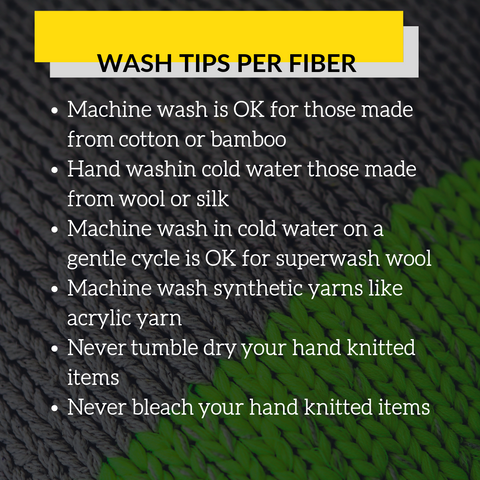
How to Care for Your Hand Knits
Caring for your hand knits can seem daunting when you’re just starting out, but with this guide, you’ll see that caring for hand-knitted items isn’t that difficult at all!
We’ve all been there-you're a new knitter and have just finished a beautiful project and suddenly realize that you either don’t know how to wash it or (horror!) wash it wrong and end up with a felted clump of wool. So, before you toss your new project in the wash or put it in the cupboard until next season, first read this article.
The main thing to remember with handknits is to be gentle. This goes for washing and storage. But let’s start with washing the item you’ve just knitted.
A Step-By-Step Guide to Washing Hand Knits
When you’re ready to wash your hand-knitted item, first look at the label of the wool to find out what temperatures it can be washed at and whether it should be hand washed or is machine washable.
How to tell how an item should be washed

How the yarn is washed will also depend on the fibers the yarn is made from. For example:
- Items made from cotton or bamboo can usually be machine washed
- Items made from wool or silk should be hand washed in cold water
- Superwash wool can be washed in a washing machine in cold water and on a gentle cycle
- Synthetic yarns like acrylic yarn can be washed in a washing machine
- Never tumble dry your hand knitted items
- Never bleach your hand knitted items
A shorthand to remember is that plant fibers can be washed in the washing machine and animal or protein (silk) fibers should be hand washed. When you’re working with a mixture of fibers, it’s always best to err on the side of caution and to wash the item by hand.
How to hand wash a hand-knitted item
When you’re going to hand wash a knitted item, you’ll need a cleaning solution or detergent that is specially made for wool. This will ensure that the wool itself isn’t damaged and that you’ll have many years of wearing and using the item.
- Now, to wash the item, fill a sink or bathtub with enough cool water that the item, for instance, a scarf, can be submerged in the water completely. Add your detergent or cleaning solution to the water and mix the water well before placing your scarf in the water and gently pushing it under the water.
- Let it soak for about 15 minutes and then gently agitate the scarf in the water. Be careful not to wring or scrub it.
- Drain the water and add new, clean water to gently rinse the scarf. If you are washing a blanket, for example, you’ll probably need to rinse it a few times to make sure that all the cleaning solution has been removed.
- Once you see that the water is clear from any soap suds, gently press the water from the knitted scarf. Don’t wring it out, but transfer it to a clean, dry towel.
- Gently roll it up with the towel, pressing down to squeeze some more water out.
- All you need to do then is to lay down another dry towel and to place your scarf on top of the towel — reshaping it as you go — and leaving it to dry flat like that. This will ensure that your knitted items don’t get stretched out.
Tips:
- Sometimes yarn will “bleed” when being washed as some of the dye is released. Be careful, therefore, not to wash different colors together. A spoonful of white vinegar can also be added to the water to keep the dye from bleeding. As KnitPal’s hand-dyed wool doesn’t bleed when being washed, you do not need to worry about this.
- If you are washing a large handmade item, like a blanket, get someone to help you press the water from it and carry it, as the wet wool can become extremely heavy.
- If you’re unsure how a certain temperature or cleaning solution will react with your yarn, first wash the swatch that you made before starting the project.
A Guide to Storing Hand Knits
Storing your hand knits in the correct way is just as important as washing them in a way that will make them last longer. By storing your knitted items correctly you won’t have the problem of the dreaded moths or other critters eating away at the wool or laying their eggs in the fabric.
Before storing your hand knits, make sure that they are washed and completely dry. If they are still damp when being put away, the fibers will mildew and rot, while dirty fibers will attract fibre=eating pests like moths and carpet beetles.
One of the most important things to remember when it comes to storing your hand knits is that they need to be folded and not be hung on clothes hangers. If they are hung they will stretch out of shape because of the weight of the wool.
Once folded, you can place them in a drawer or on a shelf with some blocks of cedarwood (a natural bug repellent) and a lavender sachet or two (which will also keep them smelling wonderful). Of course, if you have a cedar chest, all the better to keep your knitted items in.
If you’re going to store them for longer, for instance, to put them away for the season, you can put them in a linen or cotton storage bag. This will ensure that they will still be able to breathe. Ventilated plastic sweater storage boxes can also be used if necessary. Add the cedar blocks to ensure that no critters think that the knitted items are meant for them!
Tip:
If you do find the tell-tale holes that moths make in woollen items, you need to check all your items and not just treat the one item for moths. This will ensure that other items aren’t also infested and destroyed by the moths.

